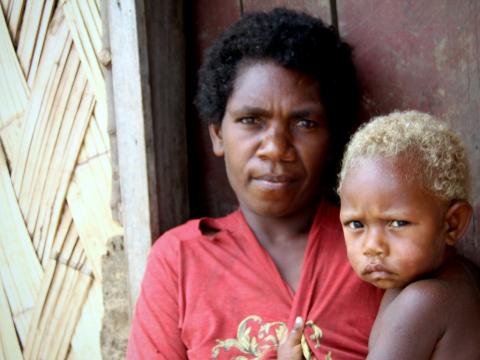Nearly broken: Feeling the effects of the El Nino

Lounapkiko is a very small, remote village characteristic of Vanuatu’s Tanna Island. Although less than 10 kilometres from the largest town on Tanna, it takes hours to reach Lounapkiko by foot, and nearly as long in a 4WD vehicle. Visitors, and villagers alike negotiate steep inclines on muddy paths that twist through the coarse bush, and the roads are empty of other vehicles or travellers.
"I don’t know how we will survive this."
The only faces that I see are of locals peering out from their gardens, curious to see who would attempt to drive a vehicle so far on such bad roads. Lounapkiko is a village of between five and six hundred people, led by Head Chief Tom and Assistant Chief Iawiko. Both men have lived in this village for their entire lives and they know everything about this community, especially the people, the land and the river.
It is the people, they say, that are complaining of hunger.
It is the land that has no kumara growing in the ground and no bananas hanging from the trees. It is the river that is drying up, forcing families to walk up to five kilometres to coastal areas for water, which is often dirty and makes the children sick.
Like the rest of Lounapkiko, Tom and Iawiko are hungry. It’s just after noon but they haven’t eaten since yesterday lunchtime, and there are no fires going in preparation to cook. Tom and Iawiko mourn their hunger, yet they are getting used to it.
In Lounapkiko, I met Rosalie, a young mum who at eight months pregnant, has cut down to one meal and one glass of water a day due to the shortages. Rosalie knows she’s not eating or drinking enough, and one month from giving birth, she’s anxious about what that means for her unborn child.
“I can see that my stomach isn’t as big as it was with my first daughter, and the baby doesn’t move around as much this time. This makes me scared for the health of my baby when it arrives.”
At what should be an exciting time for Rosalie and her family, her mind is preoccupied by concerns about food and water.
“When I return from the garden every day, I put banana leaves in the bottom of my basket so that it appears to have more food in there. I do this for my children, so they don’t see how little food there is and start to worry.”
“With the amount I’m eating and drinking, I’m worried about how long my milk will last,” says Rosalie. “When it runs out, how will I feed another mouth at the table?”
Mother-of-six Iesua is also skipping meals to feed her family. In her garden should be taro, bananas and cabbages, but Cyclone Pam destroyed the banana trees and the ground is too dry to produce much taro and cabbages. Despite this, Iesua tries to hide her growing desperation from her children.
“When I return from the garden every day, I put banana leaves in the bottom of my basket so that it appears to have more food in there. I do this for my children, so they don’t see how little food there is and start to worry.”
The people of Lounapkiko, who’ve lived through cyclones and tough El Nino seasons before, are in Chief Tom’s words, "Nearly broken.’’
“This is the toughest life has ever been, for everyone in this village. The El Nino season in 97/98 was stronger than it is now, and there have been more destructive cyclones than Pam, but we are struggling more now than we ever have before. Never before have we had two such disasters, a cyclone and El Nino so close together. Cyclone Pam destroyed the garden but this hot sun has destroyed the crops all over again. I don’t know how we will survive this.”